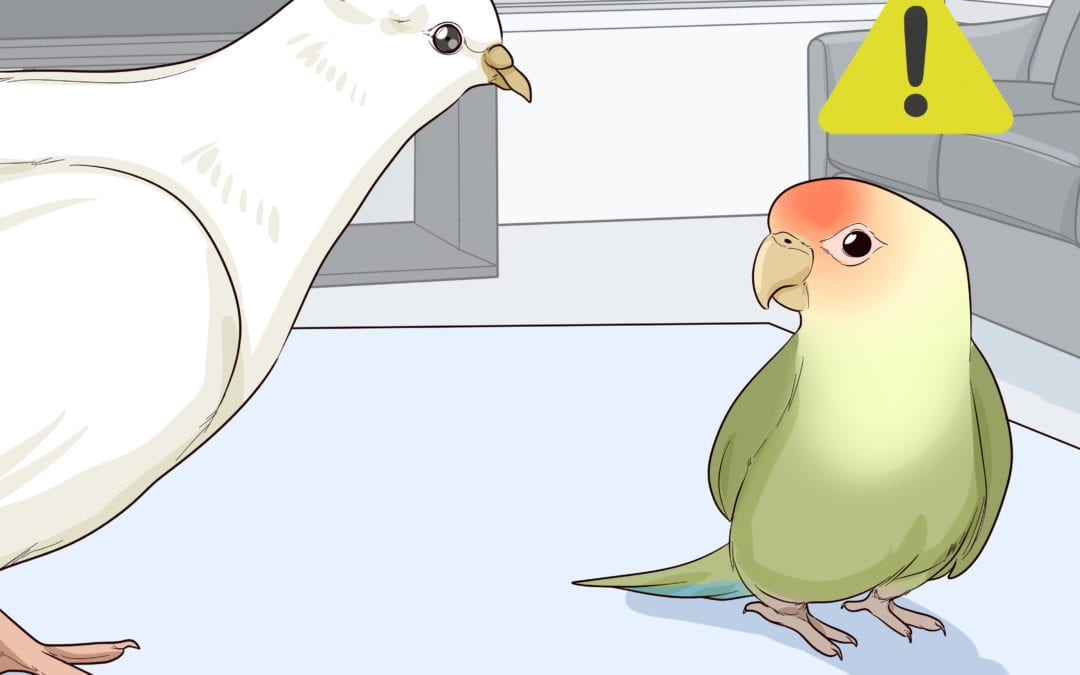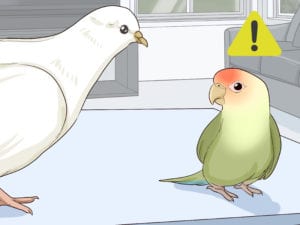There’s no such thing as a mean bird. There are, however, birds that are fearful and those with emotional problems that cause them to want to avoid being handled. When one of these birds finds itself in a situation as a pet, it can be problematic for both bird and owner, possibly leading to bird aggression. Fortunately, you can train your bird to enjoy the time it spends with you.
Why Do Some Pet Birds Have Aggressive Behavior?
The most common causes of aggression in birds are fear or previous traumatic experiences. These can lead to handling problems, bites, and attacks when birds are interacting with their owners and others. Yet, birds are complex and any number of things can lead to aggressive behavior:
Fear often develops in pet birds that were not hand-fed when they were young.
- A lack of proper socialization may lead a bird to be afraid of humans, other birds, or new experiences.
- Some birds become jealous when their owner interacts with other people. This plays on the natural “pair bonding” instinct many bird species have and, in captivity, you may be seen as your bird’s partner.
- If you adopted an older bird, it’s possible that it was mistreated or neglected in some way by its previous owner.
- Some birds become aggressive during their adolescence due to hormone changes. This will typically pass once the bird gets through this stage.
- Protecting their claimed territory, such as the birdcage or feeder, can lead to aggression.
- Birds that are stressed or lack mental stimulation may also act out.
How to Stop Aggressive Behavior
If your pet bird bites you when you try to handle it, you must set aside time each day to work on handling your feathered friend. This doesn’t have to be anything specific; you can incorporate your attempts to reduce your bird’s aggression into normal handling. For instance, you might need to work on bonding with your bird or train it to enjoy petting. You can even teach it how to do fun bird tricks. The point is that the more you work with your bird, the more it will enjoy your company, and the less aggressive it will act.
When working with your pet, a few tips and techniques will help it to learn that handling is safe and fun.
Move to a Neutral Location
If possible, move your bird’s cage to a neutral location during training sessions. Removing a bird from its “territory” can sometimes make it more willing to cooperate with its owner and prevent any territorial aggression.
Don’t Force Contact
If your bird lunges at your fingers when you place your hand near it, try not to jerk away suddenly out of fear. Your swift movements will likely make your bird even more nervous and apprehensive.
Taking it slow and easy is the better method; don’t try to force contact. Try to leave it up to the bird to decide when it’s comfortable enough to step up or accept a treat.
Try Stick Training
Training a bird to step up on a stick or a perch is referred to as “stick training.” It’s the recommended alternative to training a bird that’s not able to be handled at first. It’s a less invasive approach and easier for a bird that is fearful or was traumatized in the past to accept this way of moving without force.
Avoid Yelling
Raising your voice in anger (or pain) will not make your bird understand that it has done something wrong. In fact, it’s more likely to reinforce your bird’s bad behavior as it will love getting such a big reaction out of you. Whatever happens, avoid the temptation to yell at or punish your bird.
Bear Gifts
Offer your bird treats and speak in a soothing voice when you’re trying to handle it. Using treats and praise will help your pet be more willing to interact with you and it’s much more effective than discipline. If every interaction with your bird results in a positive experience, it will likely become more comfortable and open to a closer relationship with you.
Many people try to force interaction in the hope that this will stop the bird from resisting and it will simply give in to being handled. This is referred to as “flooding” and it’s not recommended as a training technique.
Build Trust Through Repetition
With birds, repetition and consistency are keys to training. Make time to work with your bird at least once a day to ensure success. Keep in mind that it sometimes takes a while to build up trust with a bird, so don’t give up!
Don’t Overwork Your Bird
Initially, keep training sessions at a 15-minute maximum. Birds are intelligent and sensitive creatures, and they need to have some fun in order to maintain their mental health and keep from becoming stressed.
Break the Pair Bond
If your bird becomes jealous of your interactions with other people, you will need to enlist the help of family members and visitors. The goal is to better socialize your bird and show it that these people are not a threat to the relationship it has with you.
Try various confidence-building exercises with other people and stay nearby to show your approval. You might, for instance, have visitors offer your bird a treat whenever they enter the house. To reinforce good behavior, they should also praise the bird in a happy, upbeat voice while making eye contact.
Another exercise is to lay out your bird’s food on a towel in front of the bird and have your family pick at it with their fingers, just like a bird does with its beak. If you do this regularly, your bird may want to join in the fun. They can also help you clean the cage or give your bird food or water so it is comfortable with your family’s presence.
Keep a Flexible Routine
Birds need mental stimulation and many enjoy a routine, so regular time for food, play, and other interactions each day is a good idea. However, some birds may react negatively if a routine is too rigid and gets disrupted. source
For example, if you get home from work at a certain time each day and immediately let your bird out for playtime, being late one day could lead the bird to act out. Try to employ some flexibility in your daily routines that involve your bird. It will help the bird better tolerate change and understand that things won’t always happen in a particular order or at a certain time, but it will happen.
Get Professional Help
If you put in the necessary effort, chances are you will be able to train your pet in a reasonable amount of time. If your bird is so aggressive that you cannot attempt training exercises, the first thing you should do is visit your avian veterinarian to rule out any health concerns. When no physical reasons can explain your pet’s undesirable behavior, contact a certified parrot behavior consultant for an expert opinion on your situation.
About Pigeon Patrol:
Pigeon Patrol Products & Services is the leading manufacturer and distributor of bird deterrent (control) products in Canada. Pigeon Patrol products have solved pest bird problems in industrial, commercial, and residential settings since 2000, by using safe and humane bird deterrents with only bird and animal friendly solutions. At Pigeon Patrol, we manufacture and offer a variety of bird deterrents, ranging from Ultra-flex Bird Spikes with UV protection, Bird Netting, 4-S Gel and the best Ultrasonic and audible sound devices on the market today.
Contact us at 1- 877– 4– NO-BIRD, (604) 585-9279 or visit our website at www.pigeonpatrol.ca
Bird Gone, Pigeon Gone, Seagull Gone, Pigeon problems, 1-877-4NO-BIRD, 4-S Gel, Bird Control, Pigeon Control, bird repellent,, sonic bird repellent, stainless steel , bird spikes Vancouver, Ultra Sonic Bird Control, Bird Netting, stop aggressive pet birds Canada bird deterrents, Pigeon Pests, B Gone Pigeon, Pigeon Patrol, pest controller, pest control operator, pest control technician, Pigeon Control Products, humane pigeon, pigeon deterrents, pigeon traps, Pigeon repellents, stop aggressive pet birds Sound & Laser Deterrents, wildlife control, raccoon, skunk, squirrel deterrent, De-Fence Spikes, Dragons Den, Canada bird spikes, Canada pigeon, pigeon control, pigeon patrol, pigeon. destroy pigeons, crow, starling, Pigeon Habitat, Pigeon identifications, pigeon myths, stop aggressive birds, stop aggressive pet birds


